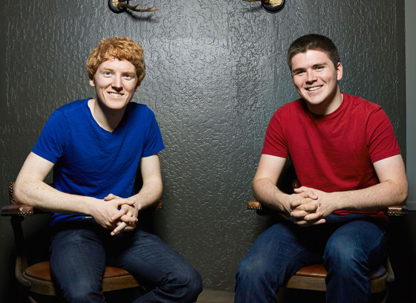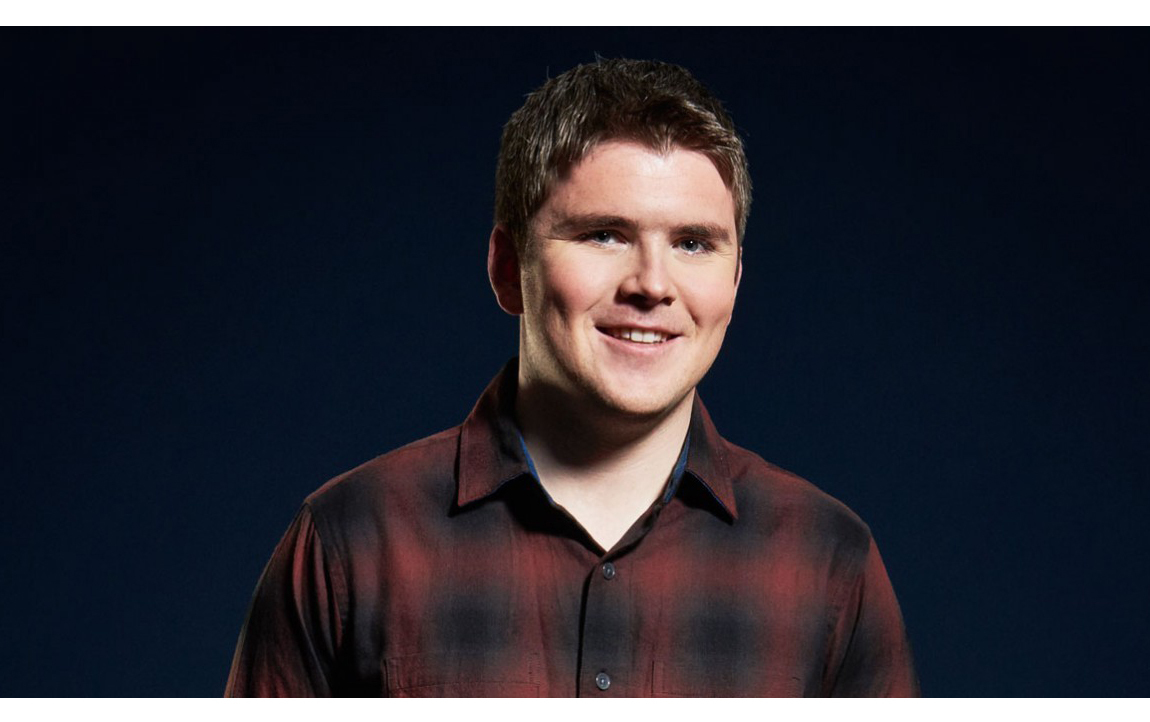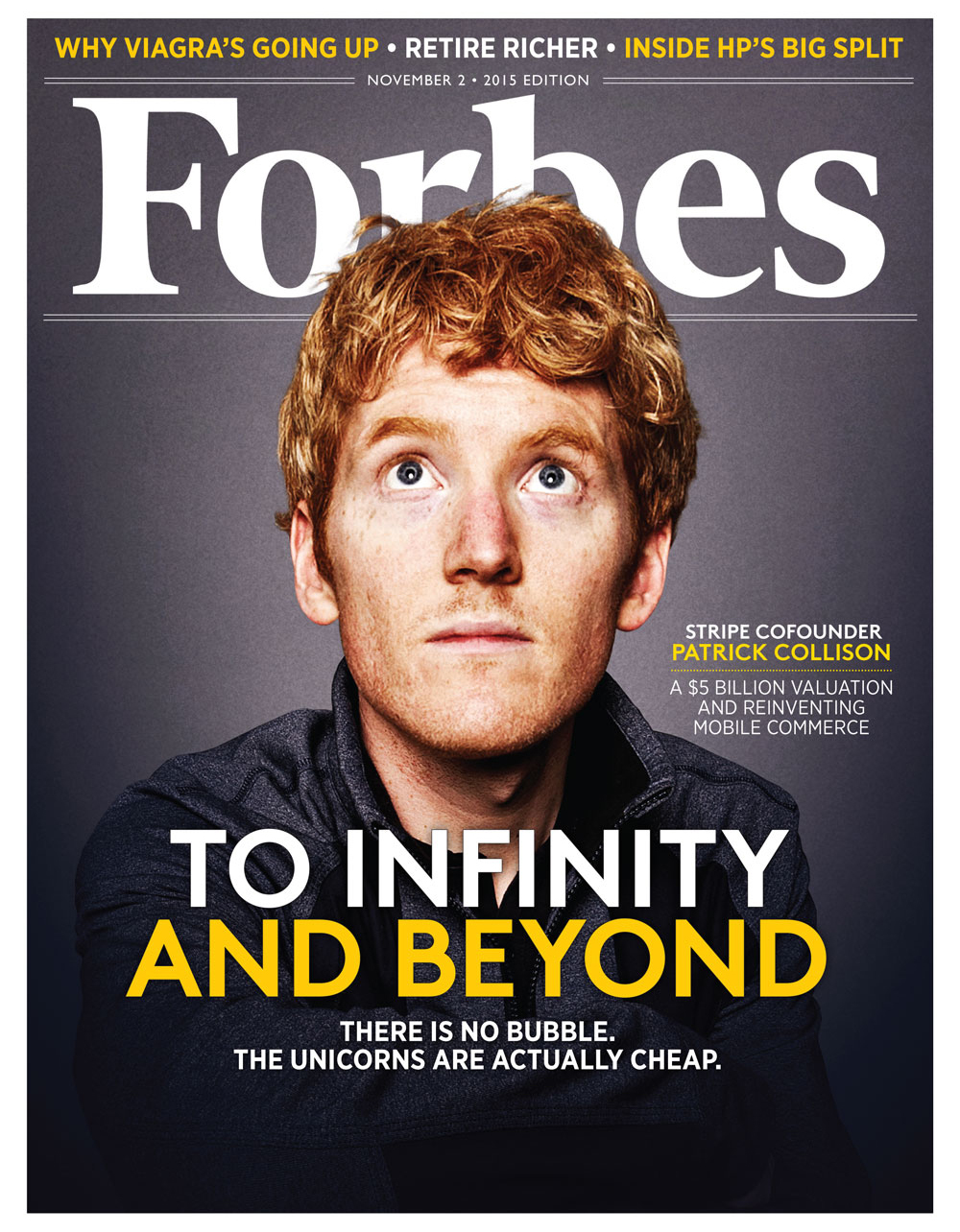How Stripe Turned Into PayPal Mobile Era
- Transfer
 When in 2010 young entrepreneurs, brothers Patrick and John Collison, were busy developing ideas for new applications, they noticed that even now, when cloud technologies and various optimization tools are available to everyone, developers still face one fairly simple, on At first glance, a problem: receiving online payments from customers. Finding a solution to this problem soon led to the creation of the company, which became one of the most promising Silicon Valley startups - Stipe , which is just like us at PayOnline, specializes in organizing payments on sites and in mobile applications. In this translation article, you will find the story of the Collison brothers, find out how Stripe began and how it looks from the inside today, how it won the love of its partners and why competitors should be wary.
When in 2010 young entrepreneurs, brothers Patrick and John Collison, were busy developing ideas for new applications, they noticed that even now, when cloud technologies and various optimization tools are available to everyone, developers still face one fairly simple, on At first glance, a problem: receiving online payments from customers. Finding a solution to this problem soon led to the creation of the company, which became one of the most promising Silicon Valley startups - Stipe , which is just like us at PayOnline, specializes in organizing payments on sites and in mobile applications. In this translation article, you will find the story of the Collison brothers, find out how Stripe began and how it looks from the inside today, how it won the love of its partners and why competitors should be wary. The first sign that John and Patrick Collison, the founders of the striking phenomenon in the world of mobile payments called Stripe, are not keen on corporate attributes - a North Face backpack. Invisible in appearance, gray with orange stripes, it lies at the foot of the table, a few meters from the entrance to the Stripe office in San Francisco. And if an ordinary visitor does not even pay attention to him, then the “stripe”, as company employees call themselves, as soon as they see him, will immediately understand that the company’s president, John Collisonis now in the office. John has neither his office, nor even a workplace, so he often works at a common table on the ground floor when he is free. His elder brother Patrick Collison , managing director of the company, works in the conditions of the few best: he sits at a small table, squeezed between the wall and the workplace of the system administrator, and sometimes also shares it with his brother. “It's great when there is room to put things,” John says, and then adds that any desktop is eventually cluttered with these very things and that it can be for the better.
The absence of their own spacious offices did not stop the Collison, two Irish immigrants a little older than 20 years old, who left colleges for their calling, from creating one of the most talked about and copied startups of the current boom, which is gradually becoming a new noticeable force in the conservative financial services industry. 5 years have passed since the creation of Stripe, and two years ago the brothers were included in the list of “ 30 entrepreneurs under 30»Forbes. And today Stripe is confidently moving towards its goal - the revolution in the field of digital payments. Over the past year alone, the size of the company increased to 380 employees, while its value rose from 3.5 billion to 5 billion dollars. Against the background of the value of its "big brother" in the industry, the Square payment service, which is now valued at $ 4 billion, this figure looks impressive.
Once working only in the US market and being a company that had to beg banks for a meeting, today Stripe routinely deals with partners like Visa, Apple Pay and Alibaba, expanding its influence to 23 countries around the world. Facebook, Twitter, and Pinterest chose Stripe to support their e-business, while traditional retailers like Best Buy and Saks Fifth Avenue chose their first projects in the mobile market. Recently, Slack also joined this list , which handed over its payments to Stripe, having refused another competitive product in its favor.
Stripe is a privately held company and therefore does not disclose profit information. Most of the hundreds of thousands of solvent customers are relatively small companies. However, the most famous clients - Lyft, Shopify, Kickstarter, Postmates and Wish - process payments worth several tens of billions of dollars, and most of these funds go through Stripe. Industry sources estimate Stripe's annual payments at around 20 billion. For each transaction processed in the USA, the company charges a fee of 2.9%, plus another 30 cents on top, which is approximately comparable to the fees of other payment companies, such as the aforementioned Square. In this case, large customers, of course, receive a discount for large volumes. All this suggests that the current annual income of the company is more than 450 million dollars.
According to the company, 27% of Americans at least once made a purchase that went through its system - a large increase compared with the result of two years ago at 3.8%. However, the Collison are not vigilant. “No matter how encouraging this success may be, we are still very far from achieving our goals,” says Patrick. “If any of our employees begins to think that we have already achieved what we wanted, it will become a big problem for us.”

John Collison, co-founder and president of Stripe
Stripe's success in facilitating digital payments is just a step towards a much more ambitious goal. The company wants to become the main system on the basis of which entrepreneurs could create new forms of commercial activity. Something like Amazon Web Services, which supports all kinds of online businesses, but with a focus on financial transactions. Stripe technologies, among other companies, already use the Lyft driver services market, Kickstarter crowdfunding platform and Slack subscription service. Last year, the company took a significant step forward by adding a tool that some analysts call the next major trend in mobile commerce. We are talking about the “buy” buttons, which allow stores to make sales by publishing goods and services in third-party applications such as Facebook, Pinterest and Twitter.
On its way, the company faced formidable rivals. One of the main competitors, Braintree, now owned by PayPal, announced that in 2015 it would carry out operations worth about $ 50 billion, which is twice the volume of Stripe operations. Braintree is also proud of the fact that its main customers include Uber and Airbnb. Another notable Stripe competitor is Adyen, a fast-growing European startup that not only has large operating volumes, but also is actively expanding into new markets.
And yet, according to Stripe estimates, only 2% of world trade today is online. Therefore, Collison and their investors, including Sequoia Capital and Andreessen Horowitz, believe that there will be enough growth opportunities for everyone. In this sense, only she herself can become the main enemy of the company as a result of her own miscalculations. “Stripe requires a higher level of professionalism than other companies, as well as the ability to better deal with stressful situations than others,” says Patrick. In other words, errors are unacceptable when it comes to working with other people's money. According to him, Stripe managed to organize the internal structure and establish processes in such a way as to carry out its activities in the objectively difficult conditions of the industry. Now, says Patrick, the company will have to learn to do the same again in the conditions of its double growth. And this is one of the challenges she will face in 2016.
The combination of success, modesty and a thoughtful approach is typical of the Collison and is the main reason for the optimism of colleagues regarding Stripe. Stripe board member Mike Moritz of Sequoia Capital calls the brothers one of the smartest people he has ever supported - high praise from a guy who had previously sponsored companies like PayPal, Yahoo, and Google.

Patrick Collison, Chief Executive Officer and Co-Founder of Stripe
The brothers share responsibility for the products, but John, 25, works with partners and sales, while Patrick, 27, is responsible for technological development and is also the public face of the company. David lee, one of the senior partners of SV Angel Investment Fund describes Patrick as a smart, balanced and charismatic leader who makes wise decisions - a combination of qualities that is rarely seen in one person.
The brothers learned to program at an early age and sold their first company, Auctomatic, for $ 5 million as teenagers. Patrick, who attended lectures at MIT for some time, has a great love for reading books. On its shelves you can find about 600 books, although he himself admits that he has completed no more than a third of them. The set of topics ranges from physics and programming to feminism, literary criticism and economics. John, who dropped out of Harvard, looks somewhat more calm, but not inferior to his brother in the sharpness of mind or versatility.
The Collison never had the ambition to turn Stripe into a real company. They just wanted to solve the problem they encountered, even when they themselves were ordinary application developers: the Internet and mobile phones simplified the task of creating global services, but paying for their services remained a terribly difficult process. Therefore, the Collison created a system that allowed developers to accept payments at a speed of several minutes. After launching the service in 2011, it quickly gained popularity first among developers of other applications, and soon with larger companies.
At the beginning of the company’s existence, John and Patrick did everything: they wrote code, dealt with support service tickets and ran after customers. But pretty quickly they realized that they should do more “global” things and therefore they took control of the company's development strategy. “This is a prerequisite for any startup that wants to outgrow its current capabilities and stop treading water,” says John. The brothers spent months on the hard work of selecting the first 10 employees, knowing that they, in turn, would attract the next wave of comers. For this first group of personnel, the Collison have allocated 10% of Stripe shares - a solid amount by the standards of conventional practice. They worked with many of the candidates for at least one week before giving them their approval. After all, all the participants who passed the selection,
Today, Stripe has grown into a much more professional company, while maintaining the same thorough approach to hiring new employees. Any employee conducting an interview, for example, has the right, if he considers it necessary, to refuse one or another candidate. At the same time, when the founders found the best candidate, they did everything they needed to lure this person into the company. According to Patrick, he spent almost 50 hours seeking a positive response from Claire Hughes Johnson, a veteran of several senior Google positions, where she recently led a well-known unmanned vehicle project. Ultimately, Claire joined Stripe as COO.
The idea of thoroughly building the company from the very beginning of its existence paid off. Stripe managed to avoid product problems and employee mistakes, even though the company doubled each year. Today, talented workers flock to Stripe from everywhere, not only because of its growth rate, but also, for the most part, because people simply want to work with Collison. “They are at the very top of the unspoken hierarchy of the Valley,” says Aron Levy, Box's CEO , who was once a mentor to both brothers. The sales department, once made up of just 2 people, has grown to 20 in the last two years. In order not to concede foreign territories to Adyen and other competitors, the team for working with foreign banks, regulators and customers was increased during the same time from 5 to 70 people.
Stripe has grown with its most successful customers thanks to its flexibility. When Lyft decided in early 2015 that he needed to speed up the process of paying his drivers, the company turned to Stripe. In December, Lyft launched Express Pay, an option that allowed drivers not to wait a few days and receive payment for their services almost instantly. This feature required Stripe to find a way to abandon the ACH network, traditionally used for electronic payments, and instead create a service that allowed transfers to drivers' bank accounts through their debit cards.
A similar situation occurred with Twitter, which turned to Stripe for help in implementing its first payment product. Twitter wanted to simplify the sale of goods for thousands of large and small sellers by adding a buy button to their application. This was a serious and difficult task, largely because sellers used dozens of different technology platforms to support their online services. Here's how Nathan Hubbard, Twitter Commercial Vice President, described the result:
“Electronic payments before their arrival were like a plate of spaghetti: everything was mixed up, so that it was difficult to figure it all out. But they [Stripe] simplified the whole process, both for developers and webmasters, so we didn’t even have to worry about anything. "
Working with Twitter also helped form the basis for Relay, a product that allows stores to sell products through third-party applications and greatly simplifies this process. Stripe’s ability to simplify complexity really appealed to Stuart Butterfield, CEO of Slack’s leading corporate messenger. Last year, Slack refused Braintree services in favor of Stripe just because of the opportunities that the company provides for working with different currencies and types of payments, and also because of the ways to integrate Stripe applications with the company's accounting software.
“There are so many very different, completely delusional nuances in the matter of transferring money,” Butterfield admits. “And Stripe was able to make everything a lot easier.”
The Strips sometimes speak of their main mission as an increase in Internet GDP. Of course, this figure can grow without Stripe. The Collison understand that in order to play a key role in this, they will need to bring Stripe out of the startup hangout straight into international commerce. They will also have to continue to develop new products, such as Relay, which simplifies the emergence of new business activities, no matter what bizarre forms they take. An example is Beepi, a fast-growing Stripe customer who sells used cars online or through the app and delivers them directly to the customer’s house with a large bow on the hood. Beepi machines are one of the most expensive products sold through Stripe, and Beepi's quarterly turnover, according to its CEO Al Reznik,
“Two or three years ago, trying to brainstorm the development of commerce, you would never have thought of delivering used cars with bows on the hood,” says Patrick. “But as soon as it really happens, this idea seems completely obvious.”
Regardless of what the next apparently-popular commercial models will be, the Collison are likely to be ready for their appearance. Nobody is talking about the IPO right now: the strips focused on the basics. “The problem with many Valley companies is that they rush things and strive to overestimate their current success,” says Patrick. And the Collison, apparently, are not going to repeat this mistake. They understand that a difficult path awaits them.
